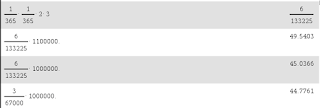
Student Absence and Student Achievement
At about the 16:10 mark, the story that is investigated is the impact of student absences (especially parents who take their kids out of school for vacation outside of the regular school holiday time). Even though this is UK data, the story resonates with teachers anywhere. I know I cringe a bit when a student presents me with the form that indicates a prolonged period of time will be missed due to a family vacation. But how much of an impact does that absence have? A great discussion ensues on the other factors that actually impact achievement beyond attendance. If you are teaching about the different types of causation that links variables, you can find a great example of correlation but necessarily causation here.
Probability and Birthdays
At the 22:40 mark, the podcast looks at the probability that a parent shares a birthday with two of their children. In particular, it mentions a number that had been reported in the past by Dr. David Spiegelhalter that there are 8 families in the UK where three children share a birthday. So that got me thinking. How did he come up with that number? I would let your students struggle a bit with this. What do they need to know to derive this number?
Hopefully after some good discussion, they may raise the following points:
- the number of families in the UK with 3 children
- the chances of having 3 people share the same birthday (a great tie-in to the traditional birthday problem)
Try it out. I did a quick search and found the family size data in 2012 for the UK from the Office for National Statistics but you may find more recent data. The great thing is if they can work backwards and determine the probability correctly and then using the number - 8 families with three children sharing a birthday - the number of families with three children determined from this calculation is very close to the statistic found in the data (off by a margin of 3.1%).
Now, the actual question of the probability of a parent sharing a birthday with two of their children is surprisingly similar (or maybe not much of a surprise). The probability is determined in the same way except now the two children can match EITHER parent which reduces the probability. The numbers that Dr. David Spiefelhalter mentions are rounded but you can confirm them easily.
Here's an example for two children families (roughly 3 000 000 in UK in 2012):
Probability of two children sharing a parent:

(Note Spiegelhalter uses the number 1 in 67000)
Then multiplying by the number of families, you get:

(Note Spiegelhalter uses the number 1 in 67000)
Then multiplying by the number of families, you get:
So about 40 families have a parent sharing their birthday with their two children in two children families (as is mentioned). It turns out that the caller who asked the question actually has three children which raises the chances of him sharing his birthday with two of his three children. A great lesson in counting - how many ways can you select two children from the three?
Here's my calculations showing the number of families where one parent shares their birthday with two of their children in families with 3 children. Note that the approximate values used by Spiegelhalter are also shown (he mentions there are 1 000 000 families when in fact there are 1 100 000 families).
Now, how do those numbers compare to Canada? You can find the data from the 2011 Census and get your students to work on it. My quick calculations show that there should be 33 families with two children that share a birthday with a parent. COOL!
This assumes that birthdays are randomly selected. We of course know that they aren't. If you want to tie in looking at the distribution of this data, here's the distribution of birthdays by month from 2008-2012. The end of the podcast discusses this distribution but its interesting to note that the distribution in Canada doesn't mirror that in the UK exactly but it is pretty close. I love finding real world ways to look at probability. Hopefully this is something you can tie into your probability lesson as well.


No comments:
Post a Comment